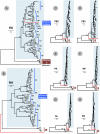A distinct lineage of influenza A virus from bats
- PMID: 22371588
- PMCID: PMC3306675
- DOI: 10.1073/pnas.1116200109
A distinct lineage of influenza A virus from bats
Abstract
Influenza A virus reservoirs in animals have provided novel genetic elements leading to the emergence of global pandemics in humans. Most influenza A viruses circulate in waterfowl, but those that infect mammalian hosts are thought to pose the greatest risk for zoonotic spread to humans and the generation of pandemic or panzootic viruses. We have identified an influenza A virus from little yellow-shouldered bats captured at two locations in Guatemala. It is significantly divergent from known influenza A viruses. The HA of the bat virus was estimated to have diverged at roughly the same time as the known subtypes of HA and was designated as H17. The neuraminidase (NA) gene is highly divergent from all known influenza NAs, and the internal genes from the bat virus diverged from those of known influenza A viruses before the estimated divergence of the known influenza A internal gene lineages. Attempts to propagate this virus in cell cultures and chicken embryos were unsuccessful, suggesting distinct requirements compared with known influenza viruses. Despite its divergence from known influenza A viruses, the bat virus is compatible for genetic exchange with human influenza viruses in human cells, suggesting the potential capability for reassortment and contributions to new pandemic or panzootic influenza A viruses.
Conflict of interest statement
The authors declare no conflict of interest.
Figures




References
-
- Reid AH, Taubenberger JK. The origin of the 1918 pandemic influenza virus: A continuing enigma. J Gen Virol. 2003;84:2285–2292. - PubMed
-
- Marx PA, Apetrei C, Drucker E. AIDS as a zoonosis? Confusion over the origin of the virus and the origin of the epidemics. J Med Primatol. 2004;33:220–226. - PubMed
-
- Gao F, et al. Origin of HIV-1 in the chimpanzee Pan troglodytes troglodytes. Nature. 1999;397:436–441. - PubMed
-
- Li W, et al. Bats are natural reservoirs of SARS-like coronaviruses. Science. 2005;310:676–679. - PubMed
Publication types
MeSH terms
Substances
Associated data
- Actions
- Actions
- Actions
- Actions
- Actions
- Actions
- Actions
- Actions
- Actions
- Actions
- Actions
- Actions
- Actions
- Actions
- Actions
- Actions
- Actions
- Actions
- Actions
- Actions
- Actions
- Actions
- Actions
- Actions
LinkOut - more resources
Full Text Sources
Other Literature Sources

